Drawings and schemes: How to find Aquila constellation
How to find Aquila constellation
"The ancient Egyptians believed that the drawings of the constellations are messages from the gods, you only need to learn how to understand them correctly."
Google translator 2022, January, original text: How to find Aquila Constellation (Russian)
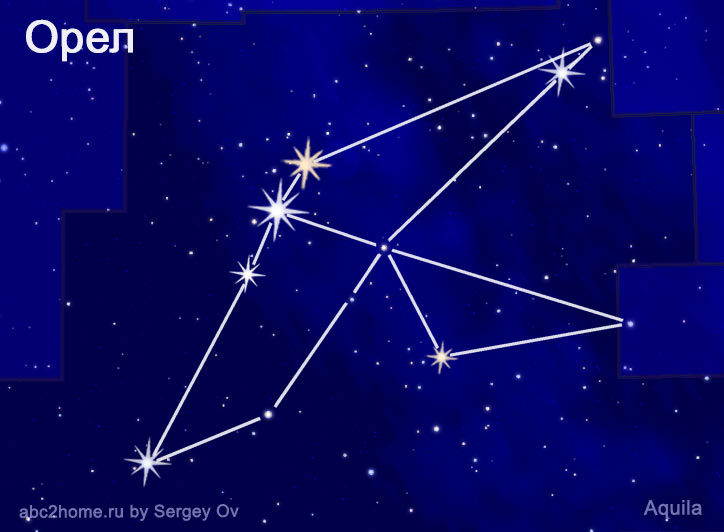 Aquila constellation
Aquila constellation
Fig. 1.Aql . Aquila constellation, diagram
The Aquila constellation can be observed at mid-latitudes of the Northern Hemisphere from February to December. The best time to get acquainted with the constellation Aquila is from July to November, when the constellation is available for observation in the evening.
Since the constellation Aquila is a setting constellation, it is important to have lines of sight from well-known non-setting constellations to determine its location.
The Aqula constellation was lucky in this regard - the main starting points for its search are the constellations Ursa Major and Cassiopeia (Fig. 17.Aql ):
Fig. 17.Aql. How to find the constellation Aquila from the constellations Ursa Major and Cassiopeia that do not set in the middle latitudes
(When copying the figure, please keep its numbering from the original article Fig. 17.Aql - " Constellation Aqula ", a link to the original is required.)
The farthest sight on the stars of the Aqula is the line of sight from the stars of the Big Dipper Phecda (γ UMa; 2,41m) - Alioth (ε UMa,1,76m), falling into the fifth brightest white-yellow star Al Mizan I (δ Aql , 3.36m ) (δ Aql, 3.36m). The line Fekda - Aliot -> Al-Mizan I is marked with a green arrow in the figure, as we see, there are no other bright stars on the sighting trajectory.
The line of sight from the "Throne" (W-asterism) of the constellation Cassiopeia Ruchbah (δ Cas; 2,66m, white) - Kaph (β Cas; 2,28m, white-yellow) is shown in the figure 17.Aql with a yellow arrow and leads to the second brightest star Aqula Tarazed (γ Aql, 2.72m, orange). When using this line of sight, it is important not to make a mistake, since at first it leads to the also orange Aljenah (ε Cyg; 2.46 m ) Cygnus and only on further following does it reach Tarazed in Aqula.
Since both the W-asterism (Throne) of Cassiopeia and the Ursa Major Dipper never set in our northern sky, they can also be used to find out, for example, how far the Aqula hid behind the horizon and how soon it will rise.
Unfortunately, an accurate direct sight directly on the brightest star in the constellation Aquila Altair (α Aql, 0.76 m , white) cannot be obtained from the bright stars of the constellations Cassiopeia and Ursa Major.
The only exact hit in Altair is obtained with the help of the stars of the Great Square of the constellation Pegasus (Fig. 18.Aql ):
Fig. 18.Aql. How to find the constellation Aqula using the stars of the constellation Pegasus
Figure 18.Aql shows that when sighting from Algenib (γ Pegasus, 2.84m, white-blue) to Markab (α Pegasus, 2.48m, blue-white), an exact hit is obtained in Altair.
Unfortunately, from the bright stars of the neighboring constellation Cygnus, it is not possible to build lines of sight leading to the bright stars of Aquila, and it becomes very valuable to find the constellation Aquila using the stars of Lyra ( Fig. 19.Aql ):
Fig. 19.Aql. How to find the constellation Aqula using the stars of the constellation Lyra
If you mentally draw a line through Vega (α Lyr, 0.03m, white) and Sheliak (β Lyr A, 3.52m, white) and lay the vector further, then the yellow arrow will hit the not very bright star Mu Aqula (μ Aql, 4.45m , orange).
Sighting from Erragal (ζ1 Lyr, 4.34m,, white) to Sulafat (γ Lyr, 3.25m, white-blue) allows you to get close to the second brightest star in the constellation Aquila Tarazed (γ Aql, 2.72m, orange) (green arrow Fig. 19.Aql).
Please note that the green line runs almost parallel to the red line of the Summer Triangle, so the Erragal - Sulafat line is auxiliary when searching for the Aquila constellation using the stars of the Summer Triangle (Fig. 16.Aql).
Now it remains only to correctly determine the angular dimensions of the constellation Aqula. In Figure 20.Aql, the constellation is shown in that position, so it can be seen overhead on a summer or autumn evening, turning to the south or southwest.
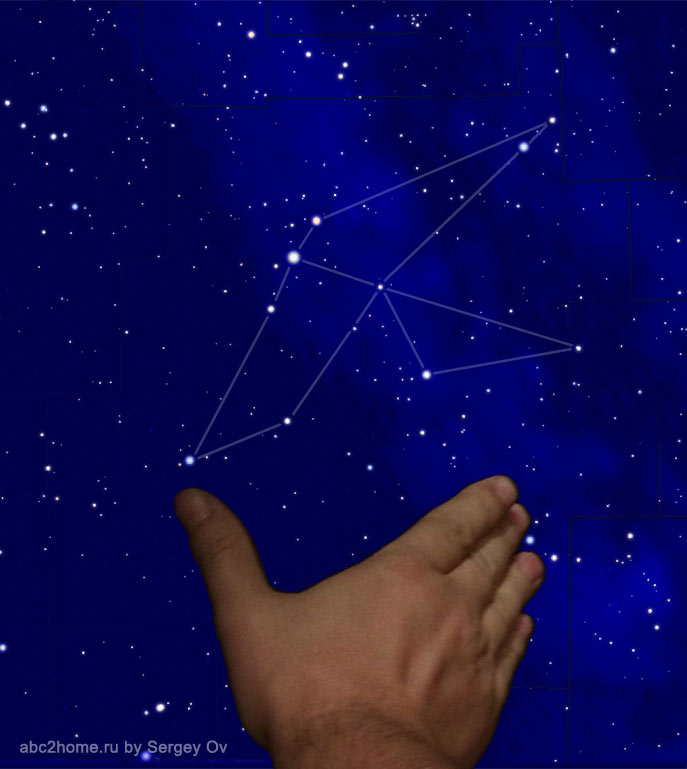
Fig. 20.Aql. Estimation of the angular size of the constellation Aquila using an outstretched hand
The angular size of the Aqula can be estimated based on the results of calculations of the angular distance between the stars of the constellation, for example, the angular distance from Altair to the second brightest star Okab is 12.2° (УAngular distance between stars - online calculation), and the angular distance between the eastern and western boundaries constellation along the line of the celestial equator is 29.25°.
Another simplest way to estimate angular distances is the arm's length estimate.
The angular distance between the thumb and forefinger of the outstretched hand of a person of normal build is 16-18° (regardless of gender and age from 7 years). The star of the Aqula against the background of an outstretched hand will look, approximately, as shown in Figure 20.Aql.
Sergey Ov (Seosnews9): Constellation Aquila (Aql) - the most ancient constellation of the Hercules group
Constellation finding guide
How to find a constellation? - step-by-step algorithm.
How to find the constellation Ursa Major
How to find the constellation Ursa Minor
How to find the constellation Cassiopeia
How to find the constellation Cygnus
How to find the constellation Boötes
How to find the constellation Orion
How to find the Virgo constellation
How to find the constellation Aries
How to find the constellation Taurus
How to find the constellation Lyra
How to find the constellation Aquila
How to find the constellation Sagittarius
This list of ways to search for constellations is gradually expanding ...
1. The Zodiac includes constellations, after which the zodiac signs are named , with the exception of the constellation Libra, which, on the contrary, was created in accordance with the zodiac sign, mainly due to the stars of the constellation Scorpio. The following constellations are included in the Zodiac family: Leo, Virgo, Libra, Scorpius, Sagittarius, Capricornus, Aquarius, Pisces, Aries, Taurus, Gemini, and Cancer.
2. We will refer the constellations to the Hercules Family:
Cygnus, Lyra, Hercules, Vulcepula, Sagitta, Aquila, Scutum, Serpens, Ophiuchus.
Fig. 16.Her. Hercules Family of constellations
●Home
 Zodiac signs
Zodiac signs
 Constellations
✔ How to find Aquila constellation
Constellations
✔ How to find Aquila constellation


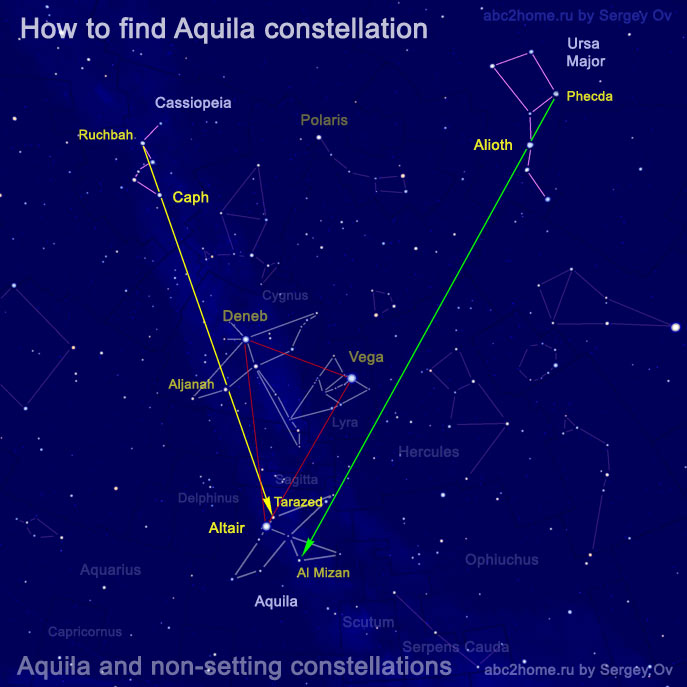
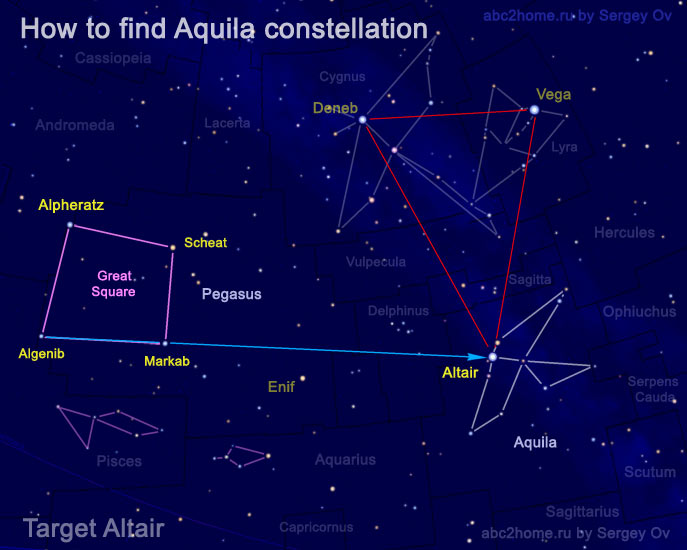
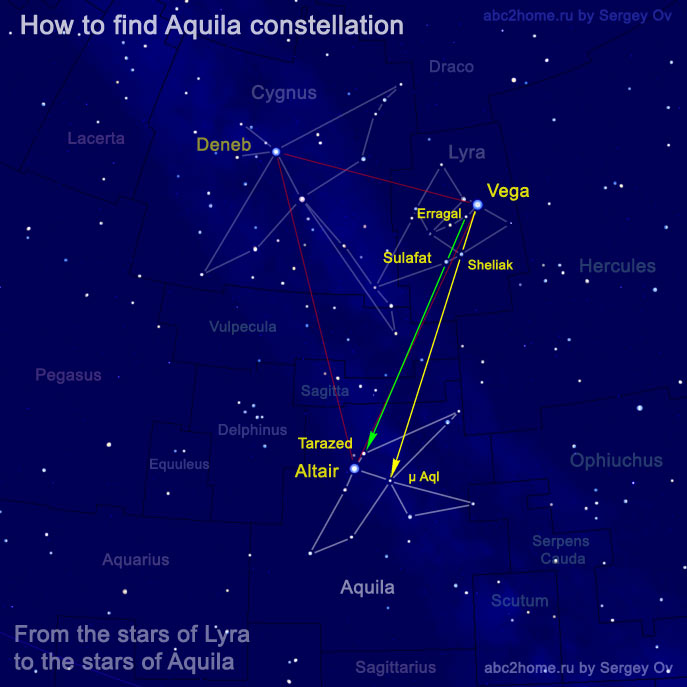
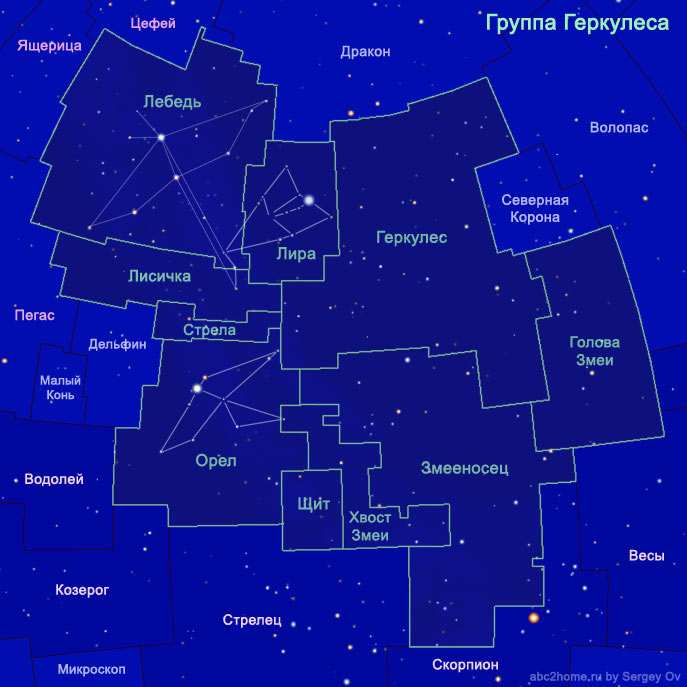
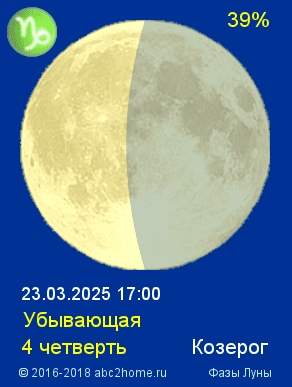


 SIGN ARIES
SIGN ARIES